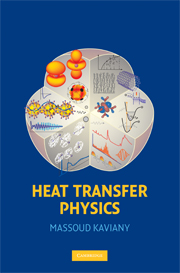Book contents
- Frontmatter
- Contents
- Preface
- Acknowledgments
- 1 Introduction and Preliminaries
- 2 Molecular Orbitals/Potentials/Dynamics, and Quantum Energy States
- 3 Carrier Energy Transport and Transformation Theories
- 4 Phonon Energy Storage, Transport and Transformation Kinetics
- 5 Electron Energy Storage, Transport and Transformation Kinetics
- 6 Fluid Particle Energy Storage, Transport and Transformation Kinetics
- 7 Photon Energy Storage, Transport and Transformation Kinetics
- APPENDIX A Tables of Properties and Universal Constants
- APPENDIX B Derivation of Green–Kubo Relation
- APPENDIX C Derivation of Minimum Phonon Conductivity Relations
- APPENDIX D Derivation of Phonon Boundary Resistance
- APPENDIX E Derivation of Fermi Golden Rule
- APPENDIX F Derivation of Equilibrium, Particle Probability Distribution Functions
- Nomenclature
- Abbreviations
- Glossary
- Bibliography
- Index
7 - Photon Energy Storage, Transport and Transformation Kinetics
Published online by Cambridge University Press: 06 July 2010
- Frontmatter
- Contents
- Preface
- Acknowledgments
- 1 Introduction and Preliminaries
- 2 Molecular Orbitals/Potentials/Dynamics, and Quantum Energy States
- 3 Carrier Energy Transport and Transformation Theories
- 4 Phonon Energy Storage, Transport and Transformation Kinetics
- 5 Electron Energy Storage, Transport and Transformation Kinetics
- 6 Fluid Particle Energy Storage, Transport and Transformation Kinetics
- 7 Photon Energy Storage, Transport and Transformation Kinetics
- APPENDIX A Tables of Properties and Universal Constants
- APPENDIX B Derivation of Green–Kubo Relation
- APPENDIX C Derivation of Minimum Phonon Conductivity Relations
- APPENDIX D Derivation of Phonon Boundary Resistance
- APPENDIX E Derivation of Fermi Golden Rule
- APPENDIX F Derivation of Equilibrium, Particle Probability Distribution Functions
- Nomenclature
- Abbreviations
- Glossary
- Bibliography
- Index
Summary
The radiative heat flux vector qr is given in terms of the photon intensity Iph in Table 1.1. The photon intensity, in turn, is determined by the source of radiation (including emission) and its interactions with matter (including absorption, reemission, and elastic scattering) as it travels at the speed of light in that matter. In addition to thermal emission, which is related to temperature of matter and is generally random in direction over a wide range of wavelengths, there are other stimulated and ordered emissions. Photons are also central in a wide range of energy conversions si− j (e.g., solar, flames, lasers). In this chapter, we examine various photon emission, absorptions, scatterings, and other interactions. These interactions are strongly dependent on the photon energy ħω, where ω is the angular frequency.
We refer to a propagating, coherent, EM wave and its energy (as described by the Maxwell equations), as well as a quantized wave packet or quasi-particle, both as photons. Historically, radiative heat transfer had been constructed assuming broadband radiation, but with the emergence of lasers, very narrow or discrete photon energy has become common. Here we use discrete, nonequilibrium photon energy distributions, as well as blackbody (Planck law) thermal radiation (as in a photon gas), to treat photon transport and interactions with electronic entities (e.g., electrons in isolated atoms or ions, conduction electrons, valence electrons, molecular dipoles) in matter.
- Type
- Chapter
- Information
- Heat Transfer Physics , pp. 461 - 578Publisher: Cambridge University PressPrint publication year: 2008



